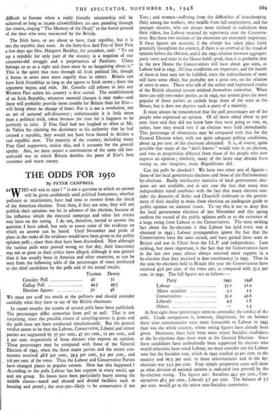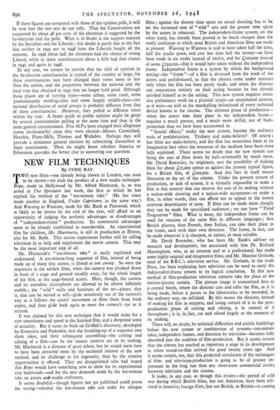THE ODDS FOR 1950
By PETER CAMPBELL
CCWHO will win in 1950? "is not a question to which an answer will be given confidently until political forecasters, whether pollsters or intuitionists, have had time to recover from the shock of the American election. Even then, if they are wise, they will not publish their opinions too far in advance of the election, because of the influence which the electoral campaign and other late events may have on the voting. I do not, therefore, intend to answer the question I have asked, but only to assess some of the evidence on which an answer can be based. Until November 2nd pride of place in the ranks of the evidence would have been given to the public opinion polls ; since then they have been discredited. Now although the various polls were proved wrong on that day, their inaccuracy was not as great as their critics have alleged, although it was greater than it has usually been in America and other countries, as can be seen from the following table of the percentages of votes attributed to the chief candidates by the polls and of the actual results.
Truman Dewey Crossley Poll 42
51
Gallup Poll 44.5 49.5 Election figures 50
46
We must not scoff too much at the pollsters and should consider carefully what they have to say of the British electorate.
In recent months the results of several polls have been published. The percentages differ somewhat from poll to poll. That is not surprising, since the possible extent of sampling-errors is great and the polls have not been conducted simultaneously. But the general verdict seems to be that the Labour, Conservative, Liberal and minor parties are supported by 37 per cent., 47 per cent., 12 per cent., and 3 per cent. respectively of those electors who express an opinion. These percentages may be compared with those of the General Election of 1945, when the three major parties and the minor con- testants received 48.8 per cent., 39.4 per cent., 9.2 per cent., and 2.6 per cent. of the votes. Thus the Labour and Conservative Parties have changed places in popular esteem. How has this happened ? According to the polls Labour has lost support in every social, age and sex group. Its losses have been particularly heavy among the middle classes—taxed and abused and denied facilities such as housing and petrol ; the over-50s—likely to be conservative if not Tory ; and women—suffering from the difficulties of housekeeping. Only among the workers, who bene-fit from full employment, and the younger electors, who are always more inclined to radicalism than their elders, has Labour retained its superiority over the Conserva- tives. But these two sections of the electorate are extremely important.' If these figures are accurate, if the change has taken place fairly generally throughout the country, if there is no reversal of the trend of opinion before the election, and if the 1945 relation between aggregate party votes and seats in the House holds good, then it is probable that in the new House the Conservatives will have about 400 seats, as Labour had in i945. All four conditions are important, and the fourth of them at least may not be fulfilled, since the redistribution of seats will have some effect, but probably not a great one, on the relation of votes to seats. Those who talk of the unfair and haphazard results of the British electoral system mislead themselves somewhat. When there are only two major parties, as in 1945, our system gives the more popular of those parties an unduly large share of the seats in the House, but it does not deprive such a party of a majority.
It must always be remembered that the poll percentages are of the people who expressed an opinion. Of all those asked about 15 per cent, have said they did not know how they were going to vote, or, rather, how they would vote if an election were held immediately. This percentage of abstentions may be compared with that for the General Election when, with not quite adequate polling conditions, about 24 per cent. of the electorate abstained. It is, of course, quite possible that many of the "don't knows" would vote in an election, and vote in proportions different from those of the people who now express an opinion ; similarly, many of the latter may abstain from voting as, one imagines, many Republicans did.
Can the polls be checked ? We have two other sets of figures— those of the local government elections and those of the Parliamentary by-elections. Really satisfactory statistics of local government elec- tions are not available, and in any case the fact that many true independents stand combines with the fact that many electors con- sider the demerits of Attlee and Churchill irrelevant to the govern- ment of their locality to make these elections an inadequate guide to public opinion on national issues. To say this is not to deny that the local government elections of last November and this spring confirm the record of the public opinion polls as to the existence of a large swing from Labour to the Conservatives. The most striking fact about the by-elections is that Labour has held every seat it obtained in 1945; Labour propagandists ignore the fact that the Conservatives have the same record, and have gained three seats in Britain and one in Ulster from the I.L.P. and independents. Less striking, but more important, is the fact that the Conservatives have in the last two years almost always received more support in a by-election than they received in that constituency in 1945. Thus in the nine by-elections held in Britain this year the Conservatives have received 43.6 per cent, of the votes cast, as compared with 35.2 per cent. in 1945. The full figures are as follows :—
Party 1945 1948 Labour 55.1 51.0 Minor socialists 5.2 2.2 Conservatives
35.2
43.6 Liberals 4-5 1.8 Others
1.4
At first sight these percentages seem to contradict the verdict of the polls. Crude comparison is, however, illegitimate, for on balance these nine constituencies were more favourable to Labour in 1945 than was the whole country, whose voting figures have already been given. Moreover, there have been more minor Socialist candidates at the by-elections than there were at the General Election. Since these candidates have undoubtedly been supported by electors who would otherwise have voted Labour, we must consider not the Labour vote but the Socialist vote, which in 1945 totalled 50 per cent, in the country and 60.3 per cent. in these constituencies and in the by- elections was 53.2 per cent. Four simple proportion sums will show us what division of national opinion is indicated (not proved) by the by-election voting. The figures are : Socialists 44.1 per cent., Con- servatives 48.5 per cent., Liberals 3.7 per cent. The balance of 3.7 per cent. would go to the minor non-Socialist contestants. If these figures are compared with those of the opinion polls, it will be seen that the two sets do not tally. That the Conservatives are supported by about 48 per cent, of the electorate is suggested by the by-elections and the polls. What is in doubt is the support enjoyed by the Socialists and the Liberals ; this doubt is partly due to the fact that neither in 1945 nor in 1948 have the Liberals fought all the contests. In 1948 about half the electorate had the chance of voting Liberal, while in these constituencies about a fifth had that chance in 1945 and again in 1948.
In any case, we cannot be certain that the shift of opinion in the by-election constituencies is typical of the country at large, for these constituencies may have changed their views more or less than the nation, and the proportion between the national and the local vote that obtained in 1945 may no longer hold good. Although those places are of varying types—some urban, some rural, some predominantly working-class and some largely middle-class—the national distribution of social groups is probably different from that of these constituencies. Moreover, they polled at different times within the year. A better guide to public opinion might be given by several constituencies polling at the same time and thus in the same general circumstances. Five M.P.s have changed their allegiance (some involuntarily) since they were elected—Messrs. Carmichael, Horabin, Plans-Mills, Thomas and Walkden. Perhaps they will provide a miniature general election by submitting themselves to their constituents. Then we might know whether America or Edmonton provides the better clue to answering our question.





































 Previous page
Previous page